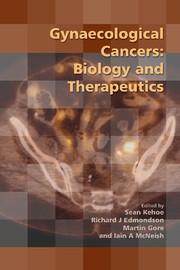Book contents
- Frontmatter
- Contents
- Participants
- Declarations of personal interest
- Preface
- SECTION 1 BIOLOGY OF GYNAECOLOGICAL CANCERS: OUR CURRENT UNDERSTANDING
- SECTION 2 THE TRANSLATION OF BIOLOGY TO THE CLINIC
- SECTION 3 IMAGING AND THERAPY: STATE OF THE ART
- SECTION 4 WHAT QUESTIONS ARE BEING ASKED BY CURRENT CLINICAL TRIALS?
- 15 Current clinical trials in ovarian cancer
- 16 Clinical trials in cervical cancer
- 17 Clinical trials in vulval cancer
- SECTION 5 CONSENSUS VIEWS
- Index
15 - Current clinical trials in ovarian cancer
from SECTION 4 - WHAT QUESTIONS ARE BEING ASKED BY CURRENT CLINICAL TRIALS?
Published online by Cambridge University Press: 05 February 2014
- Frontmatter
- Contents
- Participants
- Declarations of personal interest
- Preface
- SECTION 1 BIOLOGY OF GYNAECOLOGICAL CANCERS: OUR CURRENT UNDERSTANDING
- SECTION 2 THE TRANSLATION OF BIOLOGY TO THE CLINIC
- SECTION 3 IMAGING AND THERAPY: STATE OF THE ART
- SECTION 4 WHAT QUESTIONS ARE BEING ASKED BY CURRENT CLINICAL TRIALS?
- 15 Current clinical trials in ovarian cancer
- 16 Clinical trials in cervical cancer
- 17 Clinical trials in vulval cancer
- SECTION 5 CONSENSUS VIEWS
- Index
Summary
Epithelial ovarian cancer (EOC) is the most common cause of death among women who develop gynaecological cancer and the fifth most common cause of cancer-related death in females in western countries. The latest data show that one in 43 women will develop EOC during their lifetime. Women with a mutated BRCA1 or BRCA2 gene are at increased risk, ranging between 25% and 60% depending on the specific mutation.
Owing to its unusual tumour biology and clinical behaviour, the disease presents late, typically with extensive locoregional dissemination throughout the peritoneal cavity with surprisingly rare incidence of truly visceral metastatic disease, although nodal involvement is not uncommon and of unclear significance.
This unusual natural history has led to unique therapeutic strategies that reflect the importance of locoregional control to survival for this disease.
Primary cytoreduction: quality criteria
Surgery aimed at maximal tumour reduction, ideally without any macroscopic tumour residual disease, followed by adjuvant systemic chemotherapy typically with paclitaxel and carboplatin, constitutes the current gold standard in the primary management of the disease. Nevertheless, median progression-free survival (PFS) ranges only between 16 and 22 months, and median overall survival (OS) is rather limited, at 3—5 years. There is thus a great need for future strategies to improve the OS.
The rate of optimal residual disease (less than 1 cm), particularly the rate of complete macroscopic tumour resection, is broadly considered to be an appropriate evaluation tool for assessing surgical quality in advanced EOC.
Keywords
- Type
- Chapter
- Information
- Gynaecological CancersBiology and Therapeutics, pp. 205 - 222Publisher: Cambridge University PressPrint publication year: 2011

